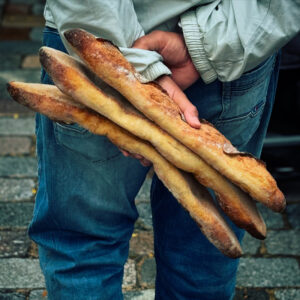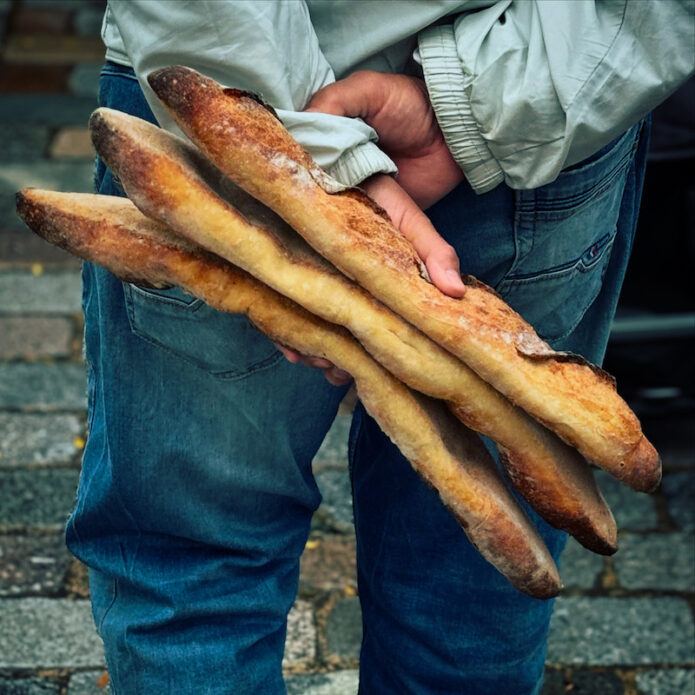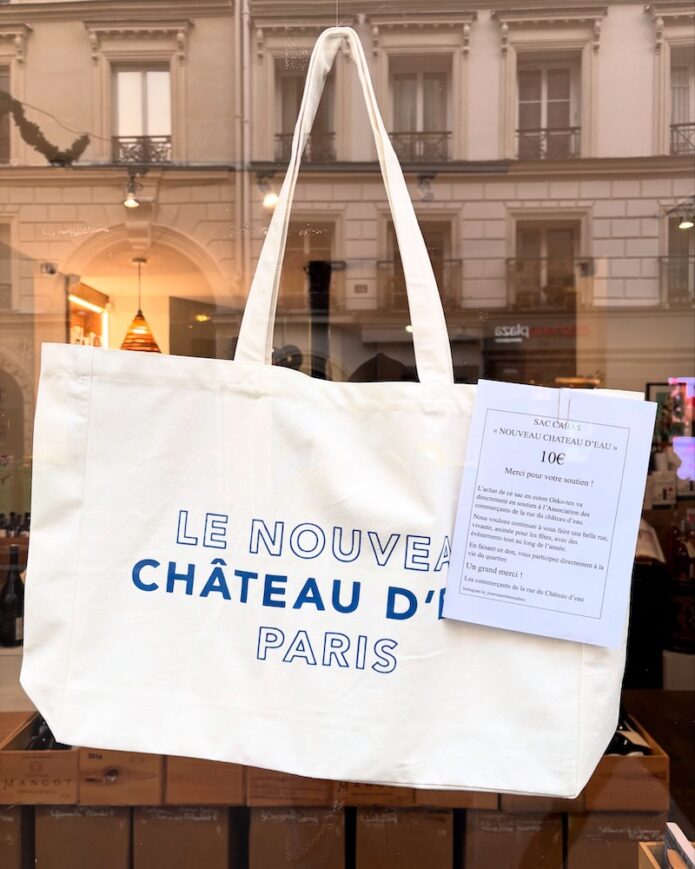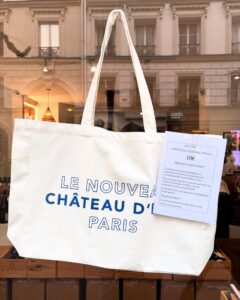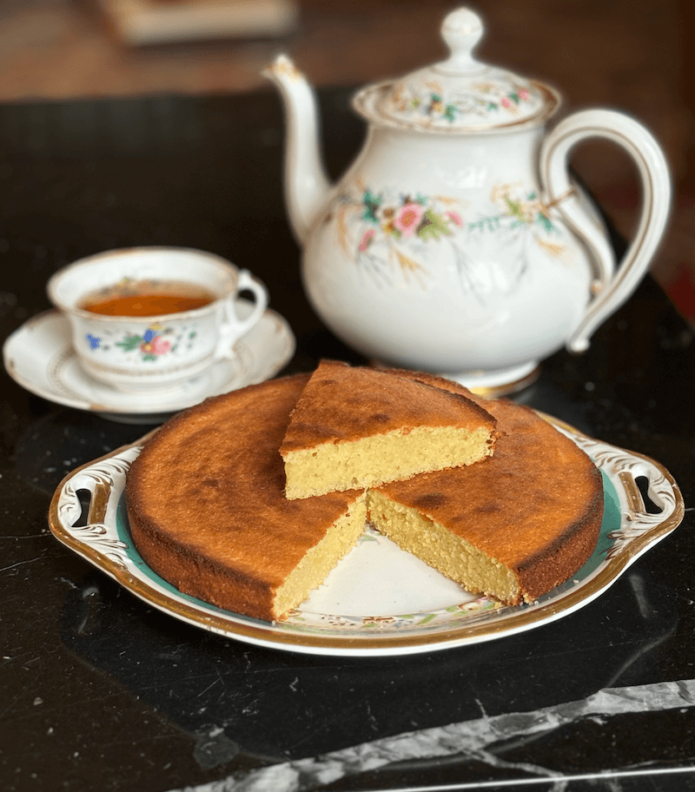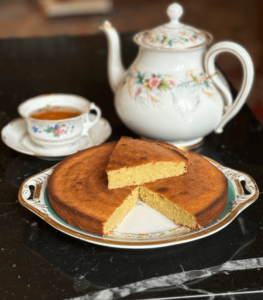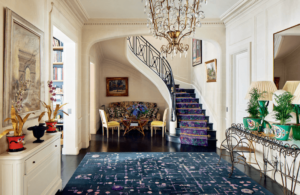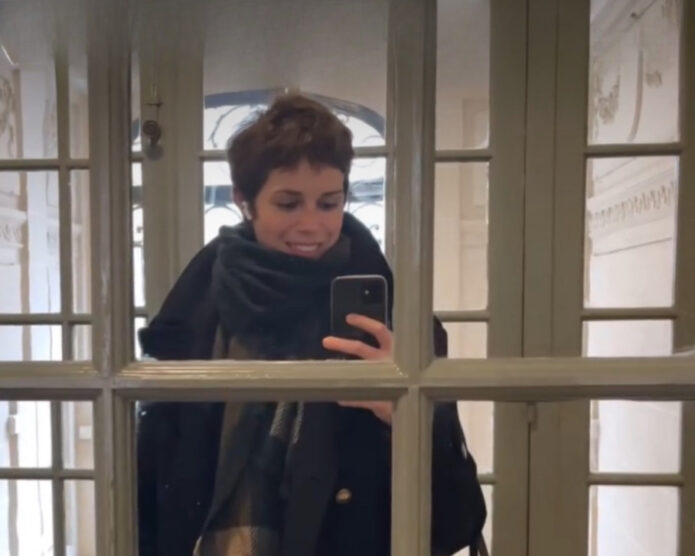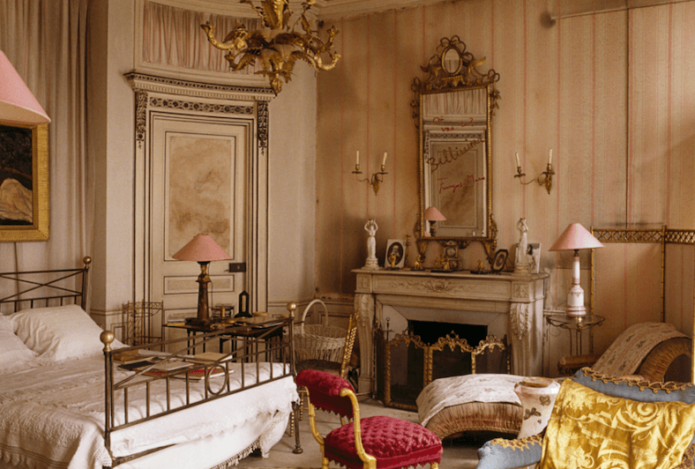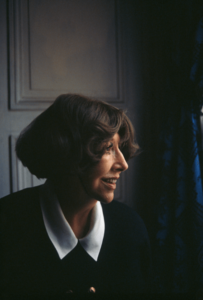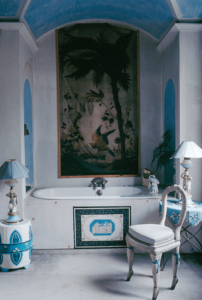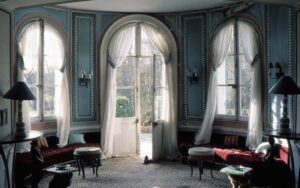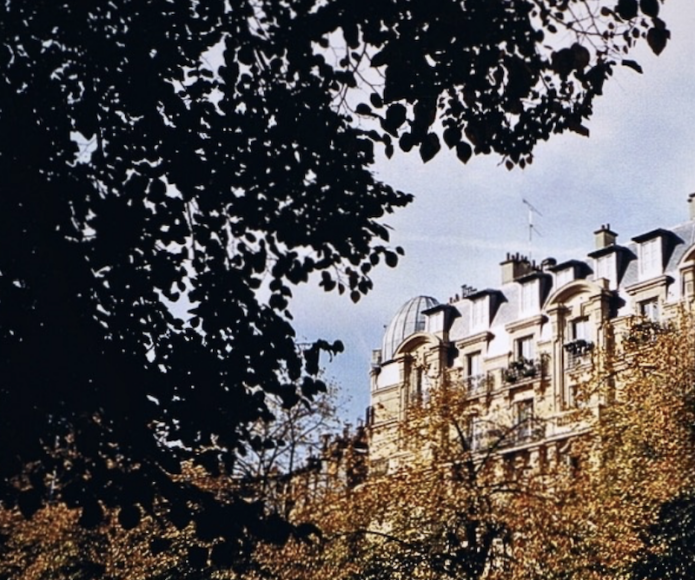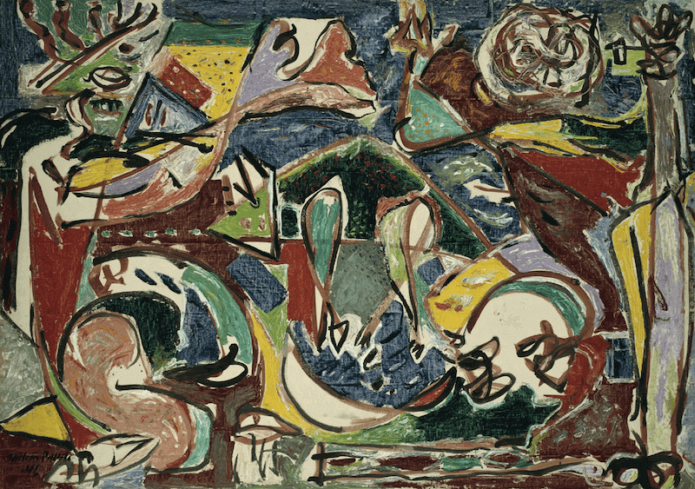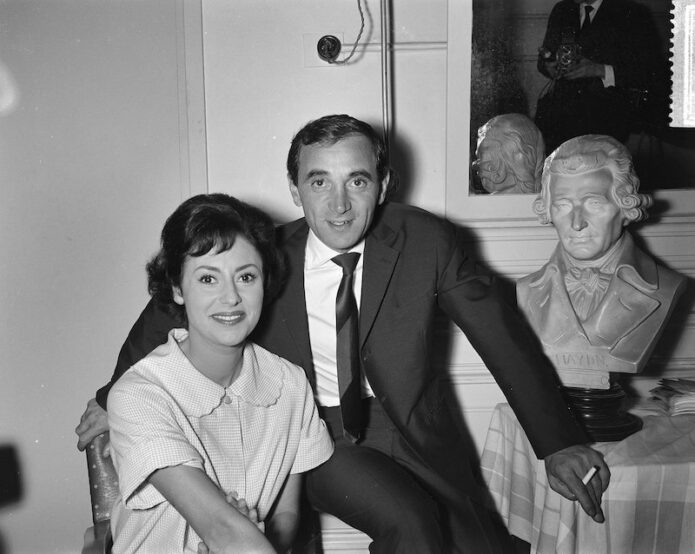Waldemar Kamer droomde als jongen van een leven in Parijs. Hij pakte zijn koffers en vertrok om er te studeren. In dit interview neemt hij je mee door zijn veertigjarige Parijse ‘wooncarrière’. Van piepkleine chambre de bonne tot comfortabel appartement. Onderweg ontpopte hij zich als journalist, schreef het boek ‘Achter de façades van Parijs’, en vond zijn weg naar het podium als acteur, zanger en regisseur.
Scroll down for the English text
De lift
In november 1994 betrok Waldemar een klassiek appartement haussmannien aan de Square Trousseau, waar hij nog altijd woont. Tien jaar lang beklom hij de trappen naar de zesde verdieping. ‘Elke dag kwam je wel iemand tegen in het trappenhuis. Een praatje hoorde erbij, soms ook als excuus om even op adem te komen,’ zegt hij lachend. ‘Kwam je er tijdens het koken achter dat je een ingrediënt was vergeten te kopen, dan belde je gewoon even bij de buren aan.’
Maar toen een bank het pand kocht en een lift installeerde, verdwenen de toevallige ontmoetingen op de trap. ‘Nu, met een supermarkt om de hoek die tot tien uur ’s avonds open is, hoeft niemand meer aan te bellen voor een vergeten boodschap. Je neemt de lift en bent zo beneden. De sfeer in het pand veranderde, de saamhorigheid verdween langzaam.’ Al kwam die saamhorigheid in de coronatijd terug, maar daarover later meer.
Onvervalste romanticus
Op veertienjarige leeftijd vergezelde Waldemar zijn moeder naar Parijs, waar zij als harpiste zou repeteren voor een concert. Nadat hij zijn taak had volbracht – hij moest het kostbare instrument drie trappen naar boven dragen – dwaalde hij door de stad. Hij bezocht het Louvre en het Musée Rodin, dat tot op de dag van vandaag zijn favoriete museum in Parijs is. Als onvervalste romanticus droomde Waldemar van een leven in Parijs: ‘Ik wilde kunstgeschiedenis studeren, wonen in de Rue de Varenne, waar het Musée Rodin staat, en een scriptie schrijven over Rodin en Rilke.’
Onstuimige start
Waldemars droom werd vier jaar later werkelijkheid, maar niet zonder hindernissen. Op 3 september 1984 arriveerde de 18-jarige Waldemar in de ville lumière, waar hij de eerste week zou verblijven bij de musicus waar hij toen de harp naartoe gedragen had. ‘Maar zijn vriendin was helemaal niet verheugd met mijn komst, en de volgende dag stond ik al op straat.’
In grote paniek, nog aangewezen op telefooncellen, belde Waldemar talloze mensen op. Zo kwam hij terecht bij een yogadocente die een garçon au pair zocht om voor haar jongens van vier en zes te zorgen. Het huis, gelegen in een voorstadje, bood hem een slaapplaats in de garage, een matras op de grond naast de auto. Toen zijn esoterische gastvrouw na een week een hysterische aanval kreeg, liep Waldemar het huis uit. ‘Het was duidelijk dat ik daar niet langer kon blijven, dus ik bracht de nacht door op een bankje in een park.’ De volgende ochtend stond hij opnieuw urenlang vanuit cellen te bellen.
Kamer met wasbak en koud water
Na die onstuimige start vond hij onderdak in een chambre de bonne van acht vierkante meter, vlak bij de Jardin du Luxembourg in het zesde arrondissement. ‘Ik huurde de kamer van een lieve dame uit de betere kringen die meerdere keren per dag een glas port dronk.’
‘Natuurlijk had ik romantische fantasieën. Voor mijn vertrek naar Parijs droomde ik van een kamer met een met klimop omlijst raam in Montmartre, waar duiven zachtjes langs fladderden. En van wilde nachten met de bohémiens die daar ten tijde van Picasso en Toulous-Lautrec leefden – en die ik pas na twintig jaar in Parijs echt zou beleven.’
‘De werkelijkheid was minder romantisch: oranje behang uit de jaren zeventig, een wasbak met slechts koud water. Zelfs voor een tafel om aan te studeren was geen plaats. Het werd me duidelijk: ik moest iets groters vinden.’
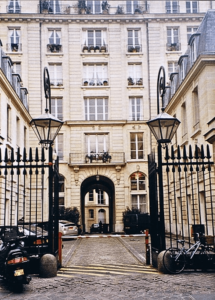
De statige pui aan de rue de Varenne
Grotere kamer met douche op de gang
En zo vond Waldemar, na zijn eerste maand in Parijs, een iets ruimere chambre de bonne van tien vierkante meter, compleet met wasbak en zowel warm als koud water. Er was een gedeelde wc en – een grote luxe – een douche op de gang. De locatie was zonder meer op stand: in de rue de Varenne in het zevende arrondissement, met blik op de tuinen van het Hôtel Matignon, de residentie van de Franse premier.
De keuze voor deze betere buurten was bewust: ‘Omdat je in een chambre de bonne elke zucht van je buren kon horen, zocht ik een kamer in gegoede wijken, waar de eigenaren vaak maar enkele kamers beschikbaar stelden om zelf zo min mogelijk gedoe met huurders te hebben.’

De minder glamorous dienstbodetrap in het pand aan de rue de Varenne die naar Waldemars chambre de bonne leidde
Eenzaamheid doorbroken
Zijn intrek op 5 oktober 1984 kwam precies op tijd voor de start van zijn studie kunstgeschiedenis. Maar contact maken met medestudenten bleek bijna onmogelijk. ‘Studiegenoten woonden bij hun ouders en toonden geen interesse in een buitenstaander; die zou toch snel weer vertrekken: slechts tien procent van de studenten zou het eerste jaar halen. Toen ik in de kantine drie jongens aansprak die in hetzelfde gebouw in de rue de Varenne woonden, reageerden ze afstandelijk. Ik verbleef in een dienstbodekamer, terwijl zij in de ruime appartementen eronder sliepen. Dat verschil lieten ze duidelijk merken: contact was niet gewenst.’
‘Pas in maart 1985 veranderde alles. Omdat ik niemand kende, bracht ik veel tijd door in musea. Ik was goed voorbereid voor het voorjaarsexamen en haalde het hoogste cijfer. Na vier maanden les over Griekse vazen was de docent woedend dat slechts één enkele student vermeld had dat deze beroemde vaas in het Louvre stond – en dat was ik, “een buitenlander”. Vanaf dat moment begonnen de andere studenten met me te praten en kwam Bertrand, mijn eerste vriend, naar me toe om mijn aantekeningen te lenen.’

Een kast bood ruimte aan een ‘keuken’ en wasgelegenheid in rue de Varenne

Waldemar in zijn chambre de bonne in de rue de Varenne
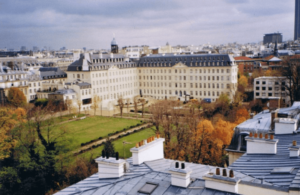
Rue de Varenne met zicht op de tuinen van het Hôtel Matignon
Kamer met tuin
In oktober 1990 maakte Waldemar de oversteek naar de rive droite (boven de Seine) en betrok een chambre de bonne van elf vierkante meter in de rue Freycinet (het zestiende arrondisement), met zicht op het Palais Galliera, de Eifeltoren en heel Parijs. De kamer had een wasbak met warm en koud water, en een wc op de gang (toen nog een simpel gat in de grond). Maar geen douche. Die maakte Waldemar in een geïmproviseerde vorm in zijn kamer. En omdat de ruimte zo donker was, bekleedde hij de wanden met zilverfolie.
De kamer bevond zich in een rij alleenstaande dienstbodekamers op het dak en had een buiten. ‘Ik legde kunstgras neer op de doorloop voor mijn deur en creëerde zo de illusie van een tuin. Omdat het binnen zo somber was zat ik zomer en winter buiten aan mijn tuintafeltje. Mijn studie had ik in 1989 afgemaakt en sinds januari 1990 werkte ik bij een theatergezelschap. Want ik had de afgelopen jaren mezelf nieuwe ambities gesteld: ik wilde ook acteur, zanger en (opera)regisseur worden.’
En alsof dat nog niet genoeg was begon hij ook als journalist. ‘Overdag werkte ik als assistent-regisseur en ’s nachts schreef ik artikelen. Daardoor kwam ik niet aan leuke dingen zoals uitgaan toe. Wanneer mijn twee kleurrijke buurjongens Marc en Nicolas als nachtvlinders vroeg in de ochtend thuiskwamen, klopten ze vaak op de deur als mijn licht nog brandde, en vertelden over hun kleurrijke nachten.’
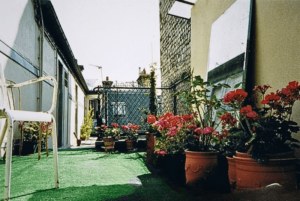
Een ’tuin’ op het dak van de Rue Freycinet

Waldemar in tuin annex terras in de rue Freycinet
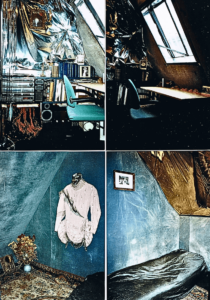
De met zilverfolie beklede wanden aan de rue Freycinet
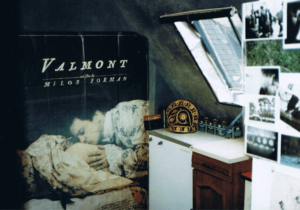
Rue Freycinet
Moment van succes
‘De eerste tien jaar in Parijs waren vol spanning. Ik wilde hier blijven wonen en werkte hard om rond te komen, terwijl ik droomde van een carrière als operaregisseur. Maar ik besefte ook dat slechts weinigen die ambitie waarmaken. Tot mijn dertigste leefde ik in die onzekerheid en twijfelde of ik het zou redden. Pas in 1994, voor mijn verhuizing naar de Square Trousseau, kreeg ik mijn eerste opdracht als operaregisseur. Toen wist ik: ik heb het gehaald. Vanaf dat moment heb ik veel meer van Parijs kunnen genieten.’
Een weloverwogen keuze
‘Net zoals bij de chambres de bonne in de betere wijken was de keuze voor het twaalfde arrondissement weloverwogen. In die tijd waren de huren in het oosten van Parijs veel lager dan in het westen, met zijn voorname quartiers. Mijn arrondissement was toen nog een echte arbeidersbuurt. Rondom metrostation Ledru-Rollin vond je slechts één café, en verder alleen maar meubelwinkels. Nu is dat niet meer zo. Door de gentrificatie – het opknappen van de buurt, waardoor prijzen stijgen en oorspronkelijke bewoners worden verdrongen – is er nu nog maar een handvol van die winkels over.’

Voor de dagelijkse boodschappen – en een portie brocante en puces – zit de Marché d’Aligre om de hoek
Eindelijk de ruimte
Zijn woning op de zesde verdieping, met de chambres de bonne boven hem, telt drie kamers. ‘Qua ruimte ging ik er enorm op vooruit. Ideaal, want als operaregisseur hield ik regelmatig vergaderingen met mijn team bij mij thuis. En in coronatijd was het een grote luxe om wat extra ruimte te hebben.’
‘Hoewel de Franse lockdowns zwaar waren – veel strenger dan in Nederland – koester ik mooie herinneringen aan die tijd. Mensen zorgden meer voor elkaar, gaven clochards pannetjes met eten… En op een gegeven moment zong ik op mijn balkon, terwijl alle buren in huis meezongen en meedansten – zelfs aan de andere kant van onze Square! Iemand anders bedacht een quiz, waarbij de ene kant van de straat het opnam tegen de andere. Die momenten gaven licht in een donkere tijd.’
Edith Piaf en Charles Aznavour
Al dat medeleven, al die gezamenlijke activiteiten gaven hoop op een andere wereld. Maar des te groter was Waldemars teleurstelling toen alles na de coronapandemie weer terugkeerde naar het oude normaal. ‘De clochard, die voor een Amerikaanse hamburgerketen sliep, werd weer zonder pardon weggestuurd en al onze gezamenlijke initiatieven hielden in één dag op. Toch heb ik door al die jaren in Parijs geleerd positief te blijven.’
‘Tot op de dag van vandaag spreken buurtbewoners me aan, en vragen ze of ik degene was die in coronatijd zong. Eigenlijk droom ik nog altijd van een carrière als zanger. Klassieke muziek, vooral Schubert, maar soms zing ik op verjaardagen of bruiloften ook het repertoire van Edith Piaf en Charles Aznavour. Het is een heerlijk gevoel om op het podium te staan, strak in pak, met een band achter je. Dat zou ik prachtig vinden. Met mijn appartement aan de Square Trousseau als thuisbasis.’
Nog meer herinneringen
Benieuwd naar Waldemars herinneringen aan de kleurrijke medebewoners van zijn Parijse woningen en de mensen die hij onderweg ontmoette? Lees zijn Achter de façades van Parijs – en geloof ons, het is een aanrader. Onze recensie vind je hier.
© Tekst: Monsieur Plusfours 2024; © beelden: Waldemar Kamer – exclusief voor Monsieur Plusfours
MELD JE AAN VOOR ONZE GRATIS NIEUWSBRIEF!
Door je in te schrijven ga je akkoord met ons privacybeleid en ontvang je automatisch onze nieuwsbrief, net zolang totdat je je weer afmeldt.
From Attic Room to Own Apartment: Waldemar Kamer’s Parisian Living Adventures
Waldemar Kamer dreamed of a life in Paris as a boy. He packed his bags and moved to the city to study. In this interview, he takes you through his forty-year Parisian ‘living career’, from a tiny chambre de bonne to a comfortable apartment. Along the way, he evolved into a journalist, wrote the book Achter de façades van Parijs, and found his way to the stage as an actor, singer, and director.
The Elevator
In November 1994, Waldemar moved into a classic Haussmannien apartment at Square Trousseau, where he still lives today. For ten years, he climbed the stairs to the sixth floor. ‘Every day, you’d run into someone in the stairwell. A chat was part of it, sometimes as an excuse to catch your breath,’ he says with a laugh. ‘If you realized you forgot an ingredient while cooking, you’d just knock on your neighbor’s door.’
But when a bank bought the building and installed an elevator, those chance encounters on the stairs disappeared. ‘Now, with a supermarket around the corner open until ten at night, no one needs to knock for a forgotten item anymore. You take the elevator and you’re downstairs in no time. The atmosphere in the building changed, and the sense of togetherness slowly faded.’ Though that sense of togetherness did return during the pandemic, but more on that later.
Unabashed Romantic
At fourteen, Waldemar accompanied his mother to Paris, where she was rehearsing for a concert as a harpist. After fulfilling his duty—carrying the valuable instrument up three flights of stairs—he wandered the city. He visited the Louvre and the Musée Rodin, which remains his favorite museum in Paris to this day. As an unabashed romantic, Waldemar dreamed of living in Paris: ‘I wanted to study art history, live on Rue de Varenne, where the Musée Rodin is located, and write a thesis on Rodin and Rilke.’
Turbulent Start
Waldemar’s dream became a reality four years later, though not without obstacles. On September 3, 1984, 18-year-old Waldemar arrived in the ville lumière, where he planned to stay for a week with the musician to whom he had once carried the harp. ‘But his girlfriend wasn’t happy about my arrival, and the next day I found myself on the street.’
In a panic, relying on public payphones, Waldemar called countless people. He ended up staying with a yoga teacher who needed a garçon au pair to care for her two boys, ages four and six. The house, located in a suburb, offered him a bed in the garage, a mattress on the floor next to the car. When his esoteric hostess had a hysterical outburst after a week, Waldemar walked out. ‘It was clear I couldn’t stay there any longer, so I spent the night on a park bench.’ The next morning, he spent hours calling again from phone booths.
A Room with a Sink and Cold Water
After that rocky start, he found shelter in a chambre de bonne of eight square meters near the Jardin du Luxembourg in the 6th arrondissement. ‘I rented the room from a kind lady from the upper class who drank port several times a day.’
‘Of course, I had romantic fantasies. Before I moved to Paris, I dreamed of a room with an ivy-framed window in Montmartre, where pigeons fluttered gently by. And of wild nights with the bohemians who lived there during the time of Picasso and Toulouse-Lautrec—nights that I would only truly experience after twenty years in Paris.’
‘The reality was less romantic: orange wallpaper from the seventies, a sink with only cold water. There wasn’t even space for a table to study at. It became clear to me that I needed to find something bigger.’

The stately building on Rue de Varenne
A Larger Room with a Hallway Shower
After his first month in Paris, Waldemar found a slightly larger chambre de bonne of ten square meters, complete with a sink and both hot and cold water. There was a shared toilet and—quite a luxury—a shower in the hallway. The location was prestigious: Rue de Varenne in the 7th arrondissement, with a view of the gardens of the Hôtel Matignon, the residence of the French prime minister.
Choosing better neighborhoods was deliberate: ‘Because in a chambre de bonne you could hear every breath of your neighbors, I looked for a room in affluent areas, where owners often rented out only a few rooms to minimize the hassle of dealing with tenants.’

The less glamorous servant’s staircase in the building on Rue de Varenne that led to Waldemar’s chambre de bonne
Loneliness Broken
He moved in on October 5, 1984, just in time for the start of his art history studies. But making contact with fellow students proved nearly impossible. ‘Classmates lived with their parents and showed no interest in an outsider; they figured I would soon leave, as only 10% of students passed the first year. When I approached three boys in the cafeteria who lived in the same building on Rue de Varenne, they were distant. I stayed in a maid’s room, while they slept in the spacious apartments below. They made the difference clear: contact wasn’t welcome.’
‘Things finally changed in March 1985. Since I didn’t know anyone, I spent a lot of time in museums. I was well-prepared for the spring exam and scored the highest grade. After four months of lectures on Greek vases, the professor was furious that only one student had mentioned that this famous vase was in the Louvre—and that student was me, “a foreigner”. From that moment on, the other students started talking to me, and Bertrand, my first friend, came to borrow my notes.’

A cupboard provided space for a ‘kitchen’ and washing area on Rue de Varenne

Waldemar in his chambre de bonne on Rue de Varenne

The view from the chambre de bonne on Rue de Varenne overlooking the gardens of the Hôtel Matignon
A Room with a Garden
In October 1990, Waldemar moved to the rive droite (north of the Seine) and settled in an eleven-square-meter chambre de bonne on Rue Freycinet in the 16th arrondissement, with a view of the Palais Galliera, the Eiffel Tower, and all of Paris. The room had a sink with hot and cold water and a toilet in the hallway (still a simple hole in the ground at the time). But no shower. Waldemar improvised one in his room. Because the space was so dark, he lined the walls with silver foil.
The room was one of several maid’s rooms on the rooftop and had access to an outdoor area. ‘I laid artificial grass on the walkway in front of my door and created the illusion of a garden. Because it was so gloomy inside, I sat outside at my garden table year-round, summer and winter. I had finished my studies in 1989, and since January 1990, I had been working with a theater company. I had set new ambitions for myself: I wanted to become an actor, singer, and (opera) director.’
And as if that wasn’t enough, he also started working as a journalist. ‘During the day, I worked as an assistant director, and at night, I wrote articles. That didn’t leave much time for fun things like going out. When my two colorful neighbors, Marc and Nicolas, returned home early in the morning after their nightlife adventures, they would often knock on my door if my light was still on and tell me about their wild nights.’

The rooftop terrace on Rue Freycinet

Waldemar on his rooftop terrace on Rue Freycinet

The silver-foil-covered walls on Rue Freycinet

Rue Freycinet
A Thoughtful Choice
‘Just like with the chambres de bonne in better neighborhoods, the choice for the 12th arrondissement was deliberate. At the time, rents in the east of Paris were much lower than in the west, with its prestigious quartiers. My neighborhood was still very working-class back then. Around Ledru-Rollin metro station, there was only one café and furniture stores everywhere. That’s no longer the case. Due to gentrification, only a handful of those stores remain.’

For daily groceries and flea market finds, the Marché d’Aligre is just around the corner
Finally, Some Space
His sixth-floor apartment, with chambres de bonne above him, has three rooms. ‘Space-wise, I made a huge leap forward. It’s ideal because as an opera director, I often hold meetings with my team at home. And during the pandemic, having some extra space was a great luxury.’
‘Although the French lockdowns were tough—much stricter than in the Netherlands—I have fond memories of that time. People took more care of each other, offering meals to the homeless. At one point, I sang from my balcony, and all the neighbors in the building joined in singing and dancing—even those across the square! Someone else organized a quiz, with one side of the street competing against the other. Those moments brought light in a dark time.’
Edith Piaf and Charles Aznavour
All that compassion and togetherness gave hope for a different world. But Waldemar’s disappointment was great when everything returned to the old normal. ‘The homeless person sleeping in front of a famous American fast-food chain was once again kicked out without mercy, and all our collective initiatives ended in a day. Still, through all my years in Paris, I’ve learned to stay positive.’
‘To this day, people in the neighborhood still recognize me and ask if I was the one singing during the lockdown. I still dream of a career as a singer. Classical music, especially Schubert, but I also sing the repertoire of Edith Piaf and Charles Aznavour at birthdays or weddings. It’s a wonderful feeling to be on stage, dressed in a sharp suit, with a band behind you. I would love that. With my apartment at Square Trousseau as my home base.’
More Memories
Curious about Waldemar’s memories of the colorful residents of his Parisian homes and the people he met along the way? Read his Achter de façades van Parijs (only in Dutch)—and believe us, it’s worth it. Our review can be found here.
SIGN UP FOR OUR FREE NEWSLETTER!
You will automatically receive our newsletter until you unsubscribe.
